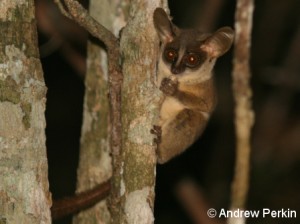Name: Justine Gwegime
EDGE species: Rondo galago (Galagoides rondoensis)
Country: Tanzania
Project: Securing future for the Rondo Galago (Galagoides rondoensis) in Southern Tanzania.
Since my youth I have been a nature lover and passionate naturalist. As I have grown up, I have seen an obvious degradation of Tanzania’s natural heritage. This saddens me and this sadness has encouraged me to commit myself to doing whatever I can to preserve my country’s biodiversity and make it accessible to my compatriot especially for flagship species which are likely to undergo extinction as results of habitat degradation. While I am a good ecologist, I believe that effective conservation requires a much wider diversity of competences and commitment. Working with one of considerable forest biodiversity conservation NGO ‘Tanzania Forest Conservation Group (TFCG)’ as Forest Condition Monitoring Officer and Biodiversity surveys Coordinator, I’m also a highly committed EDGE fellow aiming to conserve Critically Endangered primate species, the Rondo galago Galagoides rondoensis. This is only possible through estimating their abundance and distribution, assessing and campaigning for the potential threats facing this flagship species across survey sites selected as per my sampling strategy.
About my species
The lowland forest habitat contains 554 endemic species of plant and 53 endemic species of animals. The coastal forests cover a total of 6,259 km2 (9.6 endemics per 100 km2 of habitat). The coastal forests are threatened by habitat loss and degradation.
The Rondo Galago Galagoides rondoensis is an endemic primate species to just 9 coastal forest patches of Tanzania split into two fragmented populations north and south of the Rufiji River. It is also considered to be Critically Endangered (IUCN 2013) due to habitat loss and degradation and is also an EDGE species and in the Top 25 Most Endangered Primates list.
Why immediate action is needed?
There is need to assess if the species is present in remaining areas of suitable habitat plus intervening areas of known forest patches as the total area of forest in which G. rondoensis is currently known to occur was recorded not exceed 101.6 km2 following the seriously habitat loss. There is also a need to raise awareness of the species at a community and national levels to promote conservation initiatives and strategic species action plans. The southerly population in Lindi and Mtwara regions contains areas of unsurveyed habitats plus areas where surveys have not be conducted for over 10 years, which is where this project will focus.
How can I make this possible
Five survey sites have been selected as per our sampling strategies. These are Likonde escarpment, Ruawa, Litipo, Chitoa, the Noto plateau and Ziwani forest reserves. Five spatial sampling units have been selected following a stratified and randomly sampling technique. The Rondo galago are detected both acoustically (Vocalization) and visually. Vocalization are recorded using a digital sound recorder and a directional and sound playback methods will be tried by playing galago calls to illicit a response. Visually, at night using torchlight galago species are located by their bright eye-shine and distinguished by their size, face mask, overall body markings, and the tail. Disturbance survey and awareness rising to the surrounding community will also be conducted. Using special software sonograms and spectrograms will be generated that graphically illustrate sound patterns to make a qualitative comparison and quantitative measurement among Galago species. Where possible, Occupancy is calculated to determine the spatial distribution of Rondo Galago across selected survey sites.

